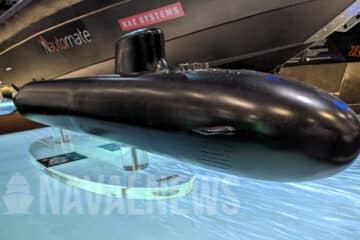BAE Systems press release
The seeker comprises long-range sensors and targeting technology that help the stealthy missile find and engage protected maritime targets in challenging electromagnetic environments.
“Our warfighters need resilient, long-range precision strike capabilities to compete with modern adversaries. We’re proud to partner with Lockheed Martin in delivering this distinct competitive advantage to U.S. warfighters.”
Bruce Konigsberg, Radio Frequency Sensors product area director at BAE Systems
LRASM combines extended range with increased survivability and lethality to deliver long-range precision strike capabilities. LRASM is designed to detect and destroy specific targets within groups of ships by employing advanced technologies that reduce dependence on intelligence, surveillance and reconnaissance platforms, network links, and GPS navigation in contested environments.
This LRASM seeker contract continues the transition of the program from Accelerated Acquisition to Low Rate Production. BAE Systems has delivered more than 50 systems to date that have demonstrated excellent technical performance over multiple test events. The company also is working to make the seeker system smaller, more capable, and more efficient to produce.
BAE Systems’ LRASM seeker technology builds on the company’s decades of experience designing and producing state-of-the-art electronic warfare technology, and its expertise in small form factor design, signal processing, target detection, and identification.
Work on the LRASM sensor will be conducted at BAE Systems’ facilities in Wayne, New Jersey; Greenlawn, New York; and Nashua, New Hampshire
-End-
About AGM-158C LRASM anti-ship missile

LRASM is designed to detect and destroy specific targets within groups of ships by employing advanced technologies that reduce dependence on intelligence, surveillance and reconnaissance platforms, network links and GPS navigation in electronic warfare environments. LRASM will play a significant role in ensuring military access to operate in open ocean/blue waters, owing to its enhanced ability to discriminate and conduct tactical engagements from extended ranges.
BAE Systems’ long-range sensor and targeting technology enables LRASM to detect and engage protected ships in all weather conditions, day or night, without relying on external intelligence and navigation data.
The advanced LRASM sensor technology builds on BAE Systems’ expertise in electronic warfare (EW), signal processing, and targeting technologies, and demonstrates the company’s ability to apply its world-class EW technology to small platforms.

Armed with a 1,000 Lbs (454 kg) penetrating blast fragmentation warhead, LRASM is low observable and likely has a range comparable with JASSM ER (around 500 nautical miles).
LRASM is designed to meet the needs of U.S. Navy and U.S. Air Force Warfighters in contested environments. The air-launched variant provides an early operational capability for the U.S. Navy’s offensive anti-surface warfare Increment I requirement.
LRASM Achieved EOC with the U.S. Navy’s F/A-18E/F Super Hornet in December 2019 and may soon find its way aboard the B-52 bomber of the U.S. Air Force.






